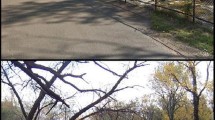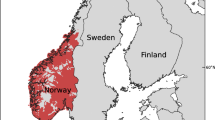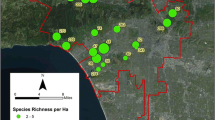Abstract
Tree canopy cover significantly affects human and wildlife habitats, local hydrology, carbon cycles, fire behavior, and ecosystem services of all types. In addition, changes in tree canopy cover are both indicators and consequences of a wide variety of disturbances from urban development to climate change. There is growing demand for this information nationwide and across all land uses. The extensive inventory plot system managed by the USDA Forest Service Forest Inventory and Analysis (FIA) offers a unique opportunity for acquiring unbiased tree canopy cover information across broad areas. However, the estimates it produces had not yet been examined for comparative accuracy with other sources. In this study, we compared four different methods readily available and with significant potential for application over broad areas. The first two, field-collected and photointerpreted, are currently acquired by FIA on approximately 44,000 plots annually nationwide. The third method is a stem-mapping approach that models tree canopy cover from variables regularly measured on forested plots and is efficient enough to calculate nationwide. The fourth is a Geographic-Object-Based Image Analysis (GEOBIA) approach that uses both high-resolution imagery and leaf-off LiDAR data and has reported very high accuracies and spatial detail at state-wide levels of application. Differences in the spatial and temporal resolution and coverage of these four datasets suggest that they could provide complementary information if their relationships could be better understood. Plot- and county-level estimates of tree canopy cover derived from each of the four data sources were compared for 11 counties in Maryland, Pennsylvania, and West Virginia across a range of urbanization levels. We found high levels of systematic agreement between field and photointerpreted, stem-mapped and field, photointerpreted and GEOBIA estimates. In several cases, the relationship changed with the level of tree canopy cover. GEOBIA produced the highest tree cover estimates of all the methods compared. Results are discussed with respect to known differences between the methods and ground conditions found in both forest and nonforest areas.













Similar content being viewed by others
References
Bechtold, W. A., & Patterson, P. L. (2005). The enhanced forest inventory and analysis program—national sampling design and estimation procedures. Asheville: USDA Forest Service, Southern Research Station. 85 p.
Coulston, J. W., Riitters, K. H., McRoberts, R. E., Reams, G. A., & Smith, W. D. (2006). True versus perturbed forest inventory plot locations for modeling: a simulation study. Canadian Journal of Forest Research, 36(3), 801–807.
Coulston, J. W., Moisen, G. G., Wilson, B. T., Finco, M. V., Cohen, W. B., & Brewer, C. K. (2012). Modeling percent tree canopy cover: a pilot study. Photogrammetric Engineering and Remote Sensing, 78(7), 715–727.
Draper, N. R., & Smith, H. (1998). Applied regression analysis. New York: Wiley.
Esposito, K. (2015). Taking good ideas from rural Wisconsin: a statewide urban forest inventory is underway for communities big and small. Wisconsin Natural Resources, 39(5), 21–23.
FAO. (2010). Global forest resources assessment 2010. Rome: Food and Agriculture Organisation.
Fiala, A. C. S., Garman, S. L., & Gray, A. N. (2006). Comparison of five canopy cover estimation techniques in the western Oregon Cascades. Forest Ecology and Management, 232, 188-197.
Goeking, S. A., Liknes, G. C., Lindblom, E., Chase, J., Jacobs, D. M., & Benton, R. (2012). A GIS-based tool for estimating tree canopy cover on fixed-radius plots using high-resolution aerial imagery. In R. S. Morin & G. C. Liknes (Eds.), Moving from status to trends: Forest Inventory and Analysis (FIA) symposium 2012 (pp. 237–241). Newtown Square: USDA Forest Service, Northern Research Station.
Hansen, M. C., Potapov, P. V., Moore, R., Hancher, M., Turubanova, S. A., & Tyukavina. (2013). High-resolution global maps of 21st-century forest cover change. Science, 342(6160), 850–853.
Homer, C. G., Dewitz, J. A., Yang, L., Jin, S., Danielson, P., Xian, G., Coulston, J., Herold, N. D., Wickham, J. D., & Megown, K. (2015). Completion of the 2011 National Land Cover Database for the conterminous United States-Representing a decade of land cover change information. Photogrammetric Engineering and Remote Sensing, 81(5), 345–354.
Jackson, T. A., Moisen, G. G., Patterson, P. L., & Tipton, J. (2012). Repeatability in photo-interpretation of tree canopy cover and its effect on predictive mapping. In W. McWilliams & F. A. Roesch (Eds.), Monitoring across borders: 2010 joint meeting of the Forest Inventory and Analysis (FIA) Symposium and the Southern Mensurationists (pp. 189–192). Asheville: USDA Forest Service, Southern Research Station.
Jenkins, J. C., & Riemann, R. (2002). What does nonforest land contribute to the global carbon balance? In R. E. McRoberts, G. A. Reams, P. C. Van Deusen, & J. W. Moser (Eds.), Proceedings of the third annual forest inventory and analysis symposium (pp. 173–179). St. Paul: USDA Forest Service, North Central Research Station.
Ji, L., & Gallo, K. (2006). An agreement coefficient for image comparison. Photogrammetric Engineering and Remote Sensing, 72(7), 823–833.
Johnson, K. D., Birdsey, R., Finley, A. O., Swantaran, A., Dubayah, R., Wayson, C., & Riemann, R. (2014). Integrating forest inventory and analysis data into a LIDAR-based carbon monitoring system. Carbon Balance and Management, 9, 3.
King, K. L., & Locke, D. H. (2013). A comparison of three methods for measuring local urban tree canopy. Arboriculture & Urban Forestry, 39(2), 62–67.
MacFaden, S. W., O’Neil-Dunne, J. P. M., Royar, A. R., Lu, J. W. T., & Rundle, A. G. (2012). High-resolution tree canopy mapping for New York City using LIDAR and object-based image analysis. Journal of Applied Remote Sensing, 6(1), 063567–1–063567–23. doi:10.1117/1.JRS.6.063567.
Martinuzzi, S., Vierling, L. A., Gould, W. A., Vierling, K. T., & Hudak, A. T. (2009). Incorporating remotely sensed tree canopy cover data into broad scale assessments of wildlife habitat distribution and conservation. Journal of Applied Remote Sensing, 3, 1–17.
McRoberts, R. E. (2010). The effects of rectification and global positioning system errors on satellite image-based estimates of forest area. Remote Sensing of Environment, 114(8), 1710–1717.
Mutlu, M., Popescu, S. C., Stripling, C., & Spencer, T. (2008). Mapping surface fuel models using lidar and multispectral data fusion for fire behavior. Remote Sensing of Environment, 112(1), 274–285.
Myeong, S., Nowak, D. J., Hopkins, P. F., & Brock, R. H. (2001). Urban cover mapping using digital, high-spatial resolution aerial imagery. Urban Ecosystems, 5, 243–256.
Nelson, M. D., Tavernia, B. G., Toney, C., & Walters, B. F. (2012). Relating FIA data to habitat classifications via tree-based models of canopy cover. In R. S. Morin & G. C. Liknes (Eds.), Moving from status to trends: Forest Inventory and Analysis (FIA) symposium 2012 (pp. 254–259). Newtown Square: USDA Forest Service, Northern Research Station.
Nowak, D. J., Hoehn, R. E., Bodine, A. R., Greenfield, E. J., & O’Neil-Dunne, J. (2013). Urban forest structure, ecosystem services and change in Syracuse. NY. Urban Ecosystems. doi:10.1007/s11252-013-0326-z.
Nowak, D. J., Bodine, A. R., Hoehn, R. E., III, Edgar, C. B., Hartel, D. R., Lister, T. W., & Brandeis, T. J. (2016). Austin’s Urban Forest, 2014. Resource Bulletin NRS-100. Newtown Square: USDA, Forest Service, Northern Research Station. 55 p.
O’Connell, B. M., LaPoint, E. B., Turner, J. A., Ridley, T., Pugh, S. A., Wilson, A. M., Waddell, K. L., & Conkling, B. L. (2014). The Forest Inventory and Analysis Database: Database description and user guide version 6.0.1 for Phase 2. USDA, Forest Service. 748 p.
O’Neil-Dunne, J. P. M., MacFaden, S.W., Royar, A. R., & Pelletier, K. C. (2012). An object-based system for LiDAR data fusion and feature extraction. Geocarto International, (May 29),1–16.
O’Neil-Dunne, J., MacFaden, S., Royar, A., Reis, M., Dubayah, R., & Swatantran, A. (2014). An object-based approach to statewide land cover mapping. Proceedings of the ASPRS 2014 Annual Conference. March 23–28, 2014. Louisville, KY. 6 pp.
Prisley, S. P., Wang, H.-J., Radtke, P. J., & Coulston, J. (2008). Combining FIA plot data with topographic variables: are precise locations needed? In W. McWilliams, G. Moisen, & R. Czaplewski (Eds.), 2008 Forest Inventory and Analysis (FIA) symposium (pp. 1–10). Fort Collins: USDA Forest Service, Rocky Mountain Research Station.
Riemann, R. (2003). Pilot inventory of FIA plots traditionally called “nonforest”. Newtown Square: USDA, Forest Service, Northeastern Research Station. 44 pp.
Riemann, R., Wilson, B. T., Lister, A. J., & Parks, S. (2010). An effective assessment protocol for continuous geospatial datasets of forest characteristics using USFS Forest Inventory and Analysis (FIA) data. Remote Sensing of Environment, 114, 2337–2352.
Riva-Murray, K., Riemann, R., Murdoch, P., Fischer, J. M., & Brightbill, R. (2010). Landscape characteristics affecting streams in urbanizing regions of the Delaware River Basin (New Jersey, New York, and Pennsylvania, U.S.). Landscape Ecology, 25, 1489–1503.
Roberts, M. R. (2007). A conceptual model to characterize disturbance severity in forest harvests. Forest Ecology and Management, 242(1), 58–64.
Slama, C. C. (1980). Manual of photogrammetry (4th ed.). Falls Church: American Society of Photogrammetry.
Toney, C., Shaw, J. D., & Nelson, M. D. (2009). A stem-map model for predicting tree canopy cover of Forest Inventory and Analysis (FIA) plots. In W. McWilliams, G. Moisen, & R. Czaplewski (Eds.), 2008 Forest Inventory and Analysis (FIA) symposium (pp. 53-1–53-19). Fort Collins: USDA Forest Service, Rocky Mountain Research Station.
Toney, C., Liknes, G., Lister, A., & Meneguzzo, D. (2012a). Assessing alternative measures of tree canopy cover: photo-interpreted NAIP and ground-based estimates. In W. McWilliams & F. A. Roesch (Eds.), Monitoring across borders: 2010 Joint meeting of the Forest Inventory and Analysis (FIA) symposium and the Southern Mensurationists (pp. 209–215). Asheville: USDA Forest Service, Southern Research Station.
Toney, C., Peterson, B., Long, D., Parsons, R., & Cohn, G. (2012b). Development and applications of the LANDFIRE forest structure layers. In R. S. Morin & G. C. Liknes (Eds.), Moving from status to trends: Forest Inventory and Analysis (FIA) symposium 2012 (pp. 305–309). Newtown Square: USDA Forest Service, Northern Research Station.
Troy, A., Grove, J. M., & O’Neil-Dunne, J. (2012). The relationship between tree canopy and crime rates across an urban-rural gradient in the greater Baltimore region. Landscape and Urban Planning, 106, 262–270.
USDA Forest Service. (2014). Forest Inventory and Analysis national core field guide, volume 1: Field data collection procedures for phase 2 plots, version 6.1. Washington, DC: USDA Forest Service.
USDA Forest Service. (2015). Forest inventory and analysis: fiscal year 2014 business report. Washington, DC: USDA Forest Service. 68 pp.
Author information
Authors and Affiliations
Corresponding author
Rights and permissions
About this article
Cite this article
Riemann, R., Liknes, G., O’Neil-Dunne, J. et al. Comparative assessment of methods for estimating tree canopy cover across a rural-to-urban gradient in the mid-Atlantic region of the USA. Environ Monit Assess 188, 297 (2016). https://doi.org/10.1007/s10661-016-5281-8
Received:
Accepted:
Published:
DOI: https://doi.org/10.1007/s10661-016-5281-8




